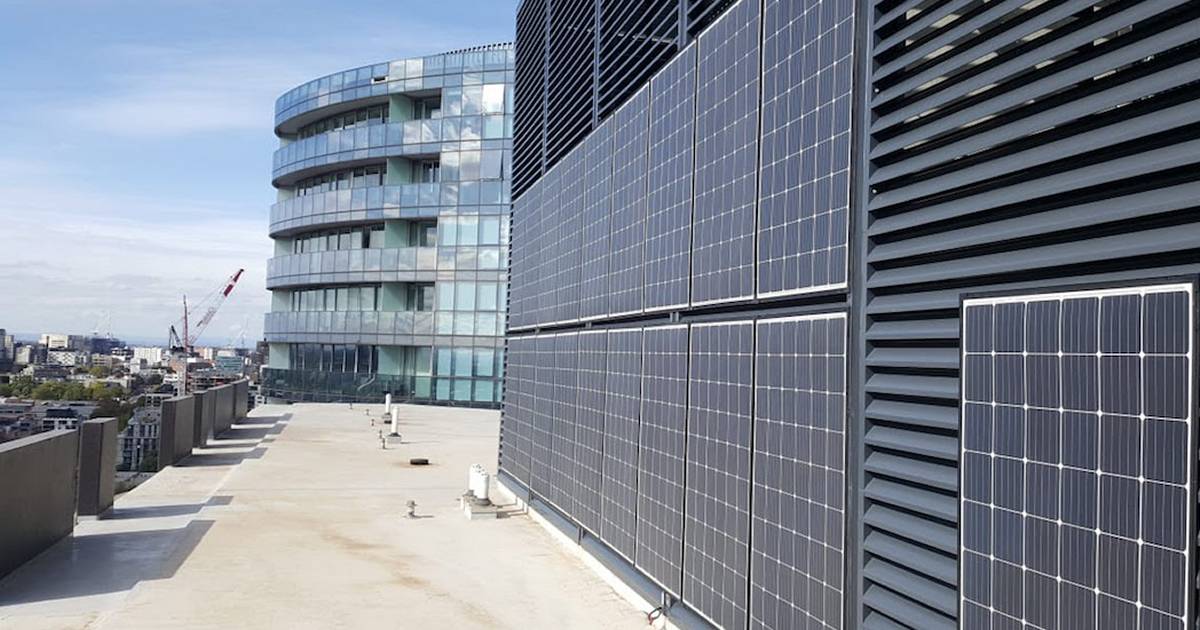
Image via Facility Management
Here’s something you don’t see often in Australia – a grid connected PV system with its solar panels installed vertically.
This article on FacilityManagement caught my eye – 87 solar panels installed vertically at the Harbour One residential development in Melbourne’s Docklands. The panels were installed in this way due to a lack of rooftop space.
Conventional panels couldn’t be used for the project as they were too heavy for the louvred surface they were to be attached to, so lightweight modules were installed (8kg vs. ~20kg).
This isn’t Australia’s first vertical solar installation, but they certainly aren’t common here yet. Existing installations include this house in Darlington, Sydney. Last year we also reported on a 30kW wall-mounted solar power system comprised of 105 solar panels at Australia’s Casey Research Station in Antarctica; which is in Australian territory. Vertical solar panels make sense in Antarctica given how low the sun is in the sky.
But as the cost of solar continues to plummet and technology advances, no doubt we’ll be seeing more this sort of thing – particularly in the form of what’s called BIPV. That stands for building-integrated photovoltaics, where solar panels are integrated directly into a building; replacing ordinary building materials.
What’s The Impact Of Installing Solar Panels Vertically?
It depends, but in any circumstance in Australia (excluding Antarctica), there’s quite a drop in overall output.
While the article doesn’t provide capacity details of the Harbour One system to work with, I’ve referred to the SolarQuotes power loss table. If the panels are installed facing north, they would be generating around 33% less electricity than if at the optimum angle of 30 – 40 degrees if I’m understanding the table correctly. The difference varies depending on orientation; but in any scenario it’s significant.
Eek! My Panels Aren’t At 30 – 40 Degrees Tilt
Don’t panic. The optimum angle varies depending on location. Most roofs in Australia are at 15° or 22.5°; so while your solar panels are probably not at their theoretically perfect tilt angle, they will be close enough to not have a major impact on electricity generation. Learn more about solar panel tilt angle – and it’s also handy to understand orientation (direction).
The folks at Harbour One obviously really wanted solar power, and good on them. As for whether it stacks up financially, the article mentions the building’s owners’ corporation will save $6,000 a year on energy costs – but the cost of the system wasn’t noted.

 RSS - Posts
RSS - Posts



It’s time for some enterprising boffins to develop some form of parabolic lensing at the front of P.V. cells so as to direct light energy at the correct angle regardless of the mounting plane of the assembly.
currently I have a hard shell roof top tent on my 4×4 canopy with a fixed solar panel on top of that. I’m thinking of removing the tent so that I can carry kayaks or other on these roof racks.
I’m thinking of fixing a solar panel on each side of the canopy doors. They have a slope of about 10-12%.
How would these panels perform?
West, east, south-west and south-east facing panels won’t produce much in winter but produce great output in the sumer. Increase the buget slightly for both west and east sides of the house and you’ll get long hours of good daytime production. This is when I use most of my daytime electricity to power airconditioning. Not so much need for daytime electricity it in the winter months so this is a good option for me.
I ran “PVWatts” with default settings in my location for various angles and facings. Because it uses weather maps, it takes into account e.g. always having cloud at certain times of day, rainfall patterns. I actually found the hourly figures interesting: why does it produce less on midsummer day on my roof than before or after? These are forecasts, not data of course.
Shed faces 340 deg (west of north), other walls: 70 deg, morning sun and 250 deg for summer evening sun. The building is 33 deg south (Watervale SA 5452) The roof is a 22 degree pitch.
Roof
Jun. kWh / month. Jan. kWh / month. Annual kWh
455. 845. 7902
340 deg wall
497 262 5024
70 deg wall
290 495 4803
250 deg wall
132 476 3610
Fairly obviously the roof wins but hours winter and summer contributing over 100W:
22 Jun 21 Dec
Roof
457 – 801 135 – 849
08.00 – 15.00 05.00 – 17.00
340 deg wall
308 – 1139 148 – 222
08.00 – 15.00 05.00 – 17.00
70 deg wall
471 – 148 2074 – 195
08.00 – 15.00 05.00 – 17.00
250 deg wall
186 – 737 148 – 1427
08.00 – 15.00 05.00 – 18.00
Now, If I wasn’t going to fit a battery, I would be tempted to fit panels on the eastish, northish and westish walls but I am, so I won’t. Space precludes more than a couple of panels and shading would necessitate micro-inverters.
The reason I didn’t work out figures for a roof at 160 deg is that the shed is monopitched – there won’t be one.
Fascinating Owen,
Have you considered a “crinkle cut” array at all? I’d like to run the numbers on a flat roof with arrays pitched at say 40° facing East And West. The idea being they’ll self clean and instead of having wall to wall panels, the pitch would create access paths for maintenance.
https://www.solarquotes.com.au/blog/self-cleaning-solar-panel-pitch/
What really needs modelling is the value of yield before 9am and after 3pm, especially if the arrays were open at the back and using bifacial modules.